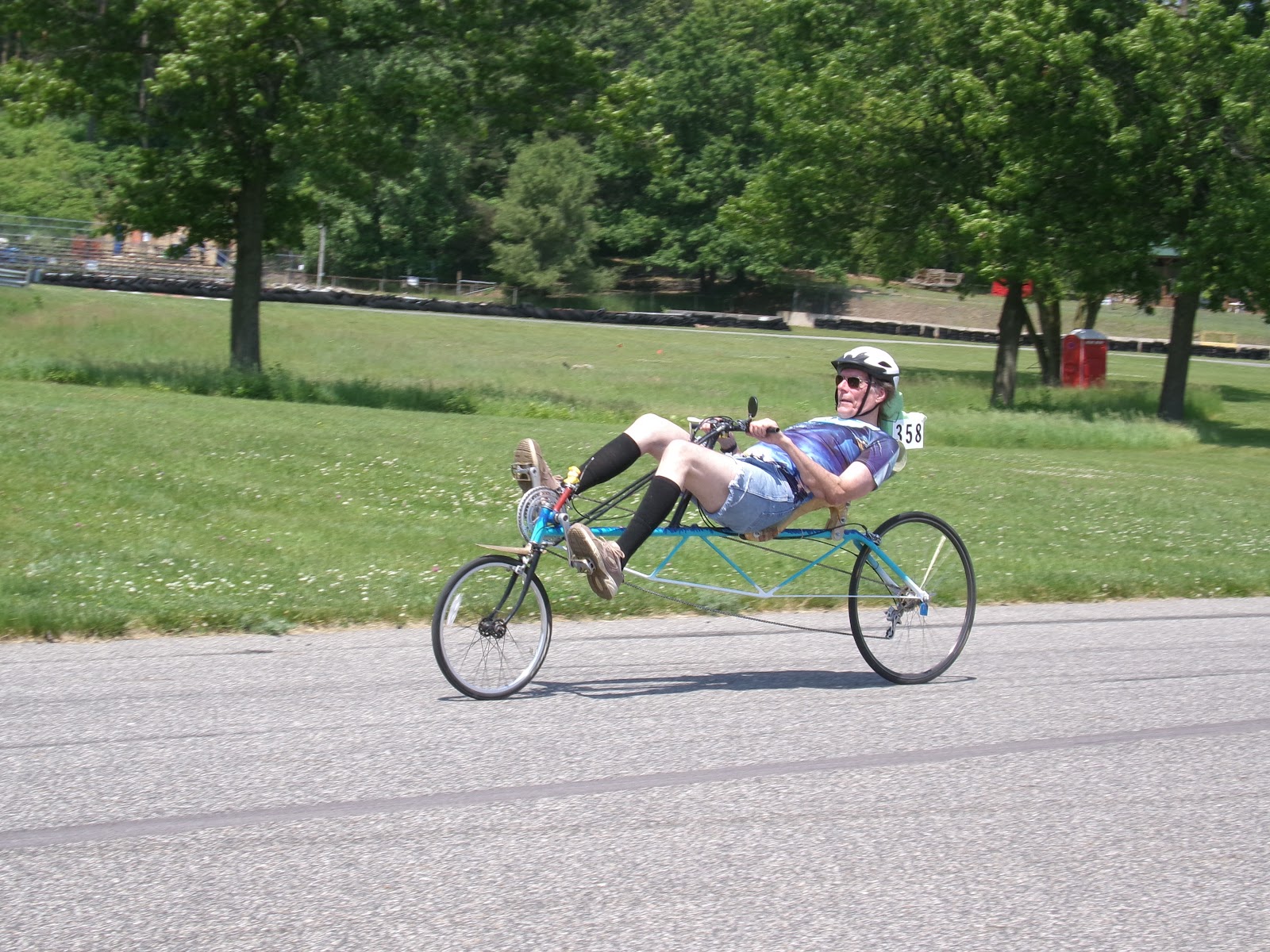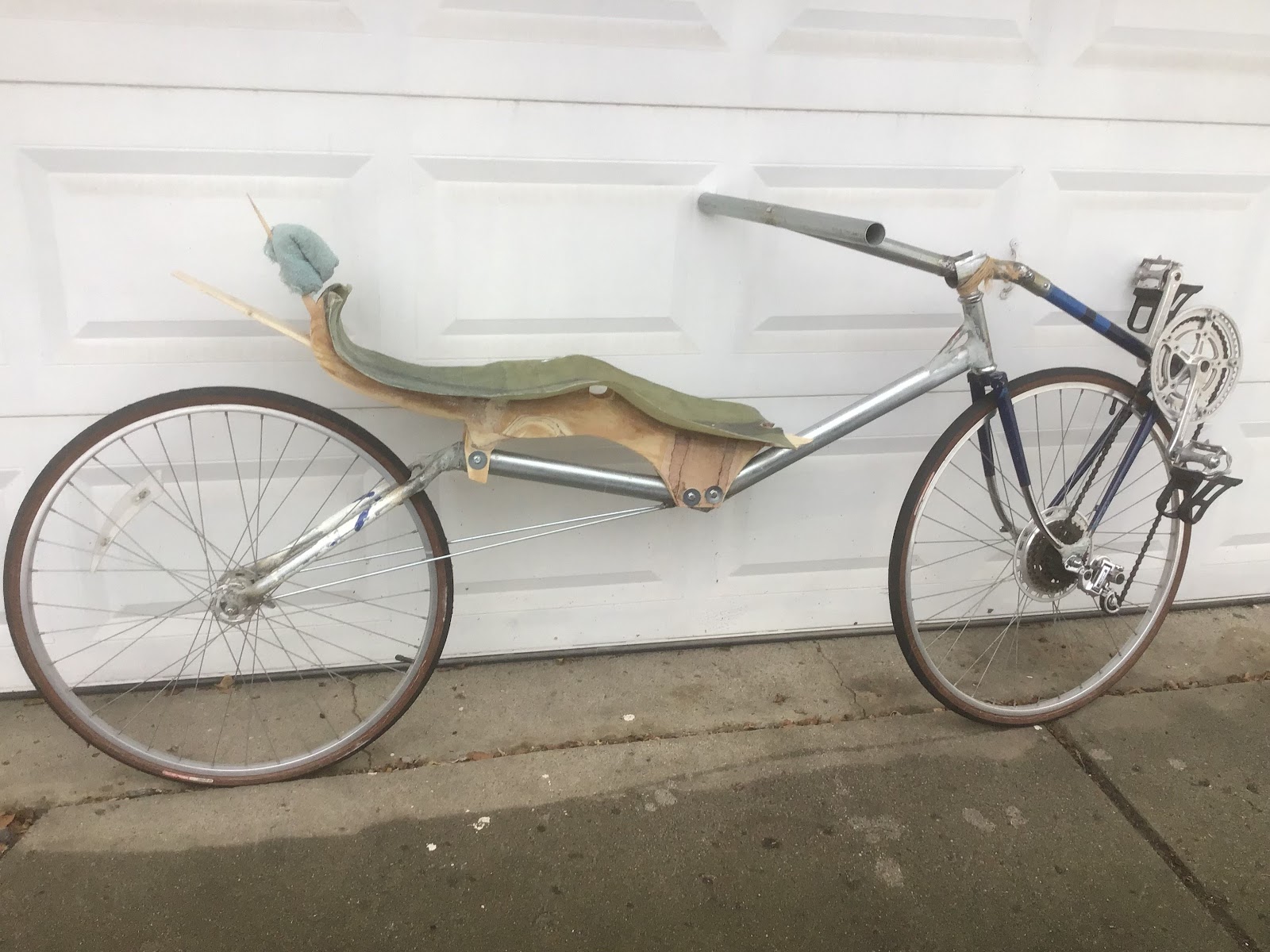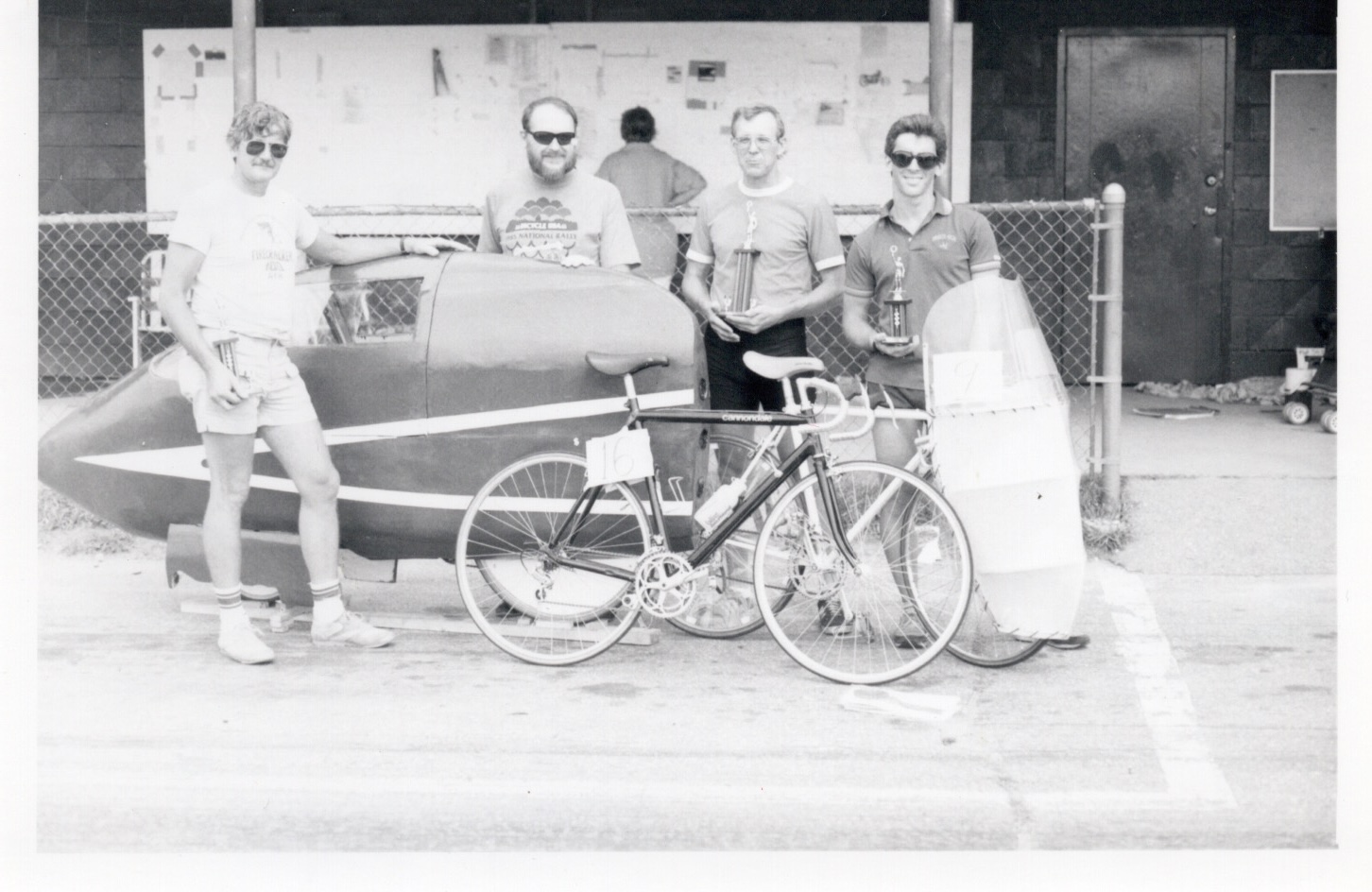The most ever velomobiles at the Michigan rally, and their owners. From left, Charles - Antoine Daignault, Laval, Quebec, VT 1; Jonathan Walters, Cincinnati, Bulk; Jonathan Minuci, Louisville, Ky., Quatro Velo 4-wheeler; Pedal Prix trike; Jane Hunn, North Manchester, Ind., motorized Quest; Dave Johnson, Olivet, Quest; Jeff Hunn, Quest; Ray Mickevicius, Wasaga Beach, Ontario, owner of the green and blue Pedal Prix trikes; and Paul Pancella, Kalamazoo, motorized Quest. (Mike Eliasohn photo)
- Waterford 2025…Final.pdf (1.9 MB)
- Waterford 2025…Results Map.jpg (1.2 MB)
- If you see any errors or omissions or have questions, please email the author at mikethebike2325@comcast.net
The 40th annual Michigan Human Powered Vehicle Rally June 7-8, 2025, at the Waterford Hills sports car racing track in Clarkston saw the best turnout in years, and possibly the most widespread geographically.
There were about 40 racers, plus other participants. The record is 50 in 2001.
And thank you Canada. The University of Toronto HPV Design Team was there with 21 students (not all raced), three student-built streamliners and five unfaired vehicles (three team-owned and two owned by students). This was the 13th year (not all consecutive) the U-T has been at our event.
Five young men and their three HPVs came from Montreal, Quebec, about 1,000 km / 621 miles, bringing one velomobile and two recumbent bicycles.
And Ray Mickevicius and his wife came from north of Toronto with two fully-faired Pedal Prix tricycles and one unfaired. The trikes were very popular for test rides.
On this side of the border, people came from Michigan (of course), Wisconsin, Illinois, Indiana, Ohio, Kentucky, Florida, Tennessee, Pennsylvania, and South Carolina. (Apologies if I missed any states.)
The University of Toronto HPV Design Team came with 21 students (the most ever), three student-built streamliners and five unfaired vehicles (three team and two student-owned). This was the 13th year the U of T team was at the rally. (Mike E. photo)
Here's the top three from each class:
Stock (29 riders / 26 vehicles) – tie: 1) Jonathan Walters, Cincinnati, Ohio, 1) Thom Ollinger, West Milton, Ohio, 3) Daryl Hanger, Mooresville, Ind., NoCom Velocraft.
Streetliner (5 riders) – 1) Jonathan Walters, 2) Ray Mickevicius, Wasaga Beach, Ontario, 3) 3) Jonathan Minuci, Louisville, Ky.
Streamliner (16 riders / 6 vehicles) – 1) Dennis Grelk, Donnellson, Iowa, 2) John Simon, Portland, 3) Tony Levand, Lemont, Ill.
Tricycles (3 riders / vehicles) – 1) Joe Pixley, Springfield, Va., 2) Eric Penn, Detroit, 3) ?.
E-assist (2 riders / vehicles) – 1) Jane Hunn, North Manchester, Ind., 2) Paul Pancella, Kalamazoo.
Women (3 riders / 2 vehicles) – 1) Kai Zabitsky, University of Toronto, 2) Erin Price, U-T, 3) Katherine Elder, U-T.
Jonathan Minuci of Louisville, Ky., gets paid by a local law firm to display the advertising on the sides of his QuattroVelo 4-wheeler. (But what if the driver was distracted by his QuattroVelo?) He finished third in the streetliner class. (Mike E. photo)
Following are the top two in each class in each event.
Saturday
One-hour: Streamliner – 1) Dennis Grelk, 24 laps, average speed 33.9 mph, 2) John Simony, 22 laps, 31.1 mph.
Streetliner – 1) Jonathan Walters, 21 laps, 29.4 mph, 2) Ray Michevicius, 19 laps, 25.5 mph.
Stock – 1) Robert Lloyd, Whitmore Lake, 19 laps, 26.9 mph, 2) Larry Oslund, Hilton Head, S.C., 19 laps, 26.7 mph.
E-assist – 1) Jane Hunn, 18 laps, 25.3 mph, 2) Paul Pancella, 18 laps, 25.1 mph.
Tricycle – 1) Joe Pixley, 16 laps, 22.3 mph, 2) Larry Seidman, 14 laps, 18.6 mph.
Tony Levand created an interesting front steering setup to avoid having a conventional head tube sticking up. (Daryl Hanger photo)
For more about Tony's creation, go to hhttp://recumbents.com/forums/topic.asp?TOPIC_ID=14142
Coast down (when riders get to the top of the hill in the hill climb, they stop pedaling, coast as far as they can go, then mark where they stopped with chalk on the pavement. Distance is not measured) : Streamliner – 1) Dennis Grelk, 2) John Simon. Streetliner – 1) Jonathan Walters, 2) Jeff Hunn. Stock – 1) Dennis Grelk, 2) Ron Wyatt, Pittsburgh, Pa. E-assist – 1) Jane Hunn, 2) none. Tricycle – 1) Joe Pixley, 2) Eric Penn. Women – 1) Kai Zabitsky, 2) Erin Price.
The standing start kilometer event, scheduled last on Saturday, was cancelled because we were running late.
Coming all the way from Quebec, about 1,000 kilometers, were (from left) Timothee Marye , Victor Chabot, Thomas Bergeron, Olivier Mangeau and Charles-Antoine Daignault. Timothee is from France, studying construction engineering at a university in Montreal. All and their HPVs came in Victor's four-door pickup truck. (Mike E. photos)
Charles-Antoine Daignault in his VT 1 waiting to start the hill climb. He and Thomas Bergeron worked for the maker, Velomtek, which closed in May, after having been in business since 2019. As of mid-June, its website was still up – www.velomtek.com.
Sunday
Flying start 200-foot sprints: Streamliner – 1) Dennis Grelk, 43.4 mph, 2) Tempest, 43.3 mph. Streetliner – 1) Jonathan Walters, 44.8 mph, 2) Ray Mickevicius, 39.5 mph. Stock – 1) Dennis Grelk, 40.2 mph, 2) Thom Ollinger, 39.6 mph. E-assist – 1) Jane Hunn, 33.7 mph, 2) Paul Pancella, 33.0 mph. Tricycle – 1) Joe Pixley, 31.8 mph, 2) none. Women - none.
Lap races – Preceding each race was a one-lap ride of silence to remember Bill Frey and David "Doc" Pearson,
25 laps (15.6 miles: Streamliners – 1) John Simon, 25 laps, 27.1 mph, 2) Tony Levand, 20 laps, 21.2 mph. Dennis Grelk dropped out after 8 laps because his chain derailed. Streetliners – 1) Jonathan Walters, 24 laps, 25.1 mph, 2) Ray Mickevicius, 24 laps, 24.0 mph. E-assist – 1) Paul Pancella, 22 laps, 23.1 mph.
In addition to competing in the rally, Mike Mowett was co-organizer, did the course set-up, posted his photos online and was key person working on the results. Here's his brief summary of the weekend (slightly edited by co-organizer Mike E.: "Well as usual, we managed to 'pull it off,' make the weekend a success. So many people helped, like Dan Glatch, Tony Levand, John Simon, Terry Gerweck, just to name a few. And of course Dennis Grelk on transponders and registration and Robert Lloyd with results, trying to crunch everything on the GoogleSheets program he set up." (photo by Hannah Dempster, U of T)
In 1982, Mike Eliasohn (left) and Terry Gerweck organized a gathering of fellow recumbent cycle owners the evening before the River Raisin Tour in the Monroe area. That led to creation of what became the Michigan HPV Rally. See article below, "40 years + of HPV Racing in Michigan." At the 40th annual, they are standing behind Terry's Tour Easy. (Steve Webber photo)
For Dennis Grelk, it's about a 530-mile drive from Donnellson, Iowa, to Clarkston – and then doing the reverse. Imagine how many "what the ?" reactions there must have been from passing or following motorists on his way to the rally and return. No. 421 is his stock class bike; the other is his streamliner. (Mike E. photo)































